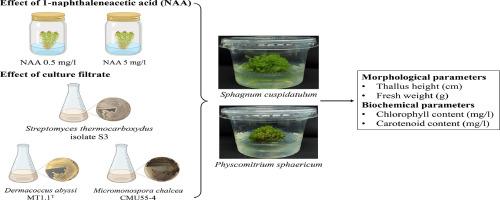Unraveling growth-promoting potential of plant beneficial actinobacteria on tropical bryophytes
IF 4.8
Q1 MICROBIOLOGY
引用次数: 0
Abstract
Bryophytes are non-vascular plants with dominant gametophyte stage that play vital ecological roles in natural ecosystems. Unfortunately, their populations are currently in decline due to habitat destruction and various anthropogenic activities. The conservation efforts for bryophytes are hampered by their slow growth rates. This study aims to investigate the potential of actinobacteria to promote the growth of bryophytes. In this study, three plant growth-promoting actinobacteria, Dermacoccus abyssi MT1.1T, Micromonospora chalcea CMU55-4 and Streptomyces thermocarboxydus S3 were cultured in International Streptomyces Project medium 2 (ISP2) broth to obtain culture filtrates containing bioactive compounds for enhancing the growth of two bryophyte species, Physcomotrium sphaericum (C. Ludw.) Fürnr and Sphagnum cuspidatulum C. Müll. Interestingly, the incorporation of actinobacterial culture filtrates into 1/16 Murashige and Skoog (MS) medium yielded superior growth performance of P. sphaericum (C. Ludw.) Fürnr and S. cuspidatulum C. Müll, as observed from the thallus height, fresh weight, total chlorophyll contents, and total carotenoid contents compared to control groups. In addition, the inoculation of M. chalcea CMU55-4 on S. cuspidatulum C. Müll grown in sterile peat moss demonstrated the highest values for thallus height, fresh weight, dry weight, total chlorophyll content, and total carotenoid content. All actinobacteria successfully colonized the moss seedlings without any observable negative impacts, indicating beneficial interactions between actinobacteria and bryophytes. This research sheds light on the potential of harnessing plant beneficial actinobacteria to enhance the growth of bryophytes for conservation purposes.

揭示植物有益放线菌对热带红叶植物的生长促进潜力
毛藓植物是具有显性配子体阶段的非维管束植物,在自然生态系统中发挥着重要的生态作用。不幸的是,由于栖息地遭到破坏和各种人为活动,它们的数量目前正在下降。由于其生长速度缓慢,阻碍了对红叶植物的保护工作。本研究旨在探讨放线菌促进红叶植物生长的潜力。在本研究中,三种促进植物生长的放线菌(Dermacoccus abyssi MT1.1T、Micromonospora chalcea CMU55-4 和 Streptomyces thermocarboxydus S3 在国际链霉菌项目培养基 2(ISP2)肉汤中培养,获得含有生物活性化合物的培养滤液,用于促进两种红叶植物 Physcomotrium sphaericum (C. Ludw.) Fürnr 和 Sphagnum cuspidatulum C. Müll 的生长。有趣的是,在 1/16 Murashige and Skoog(MS)培养基中加入放线菌培养滤液后,P. sphaericum (C. Ludw.) Fürnr 和 S. cuspidatulum C. Müll的生长表现优于对照组,这一点可以从它们的植株高度、鲜重、叶绿素总含量和类胡萝卜素总含量中观察到。此外,将 M. chalcea CMU55-4 接种到生长在无菌泥炭藓中的 S. cuspidatulum C. Müll,结果表明其叶柄高度、鲜重、干重、叶绿素总含量和类胡萝卜素总含量均为最高值。所有放线菌都成功地在苔藓幼苗上定植,没有发现任何负面影响,这表明放线菌与红叶植物之间存在有益的相互作用。这项研究揭示了利用对植物有益的放线菌促进红叶植物生长以达到保护目的的潜力。
本文章由计算机程序翻译,如有差异,请以英文原文为准。
求助全文
约1分钟内获得全文
求助全文
来源期刊

Current Research in Microbial Sciences
Immunology and Microbiology-Immunology and Microbiology (miscellaneous)
CiteScore
7.90
自引率
0.00%
发文量
81
审稿时长
66 days
 求助内容:
求助内容: 应助结果提醒方式:
应助结果提醒方式:


